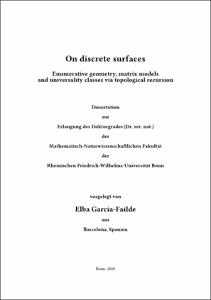On discrete surfacesEnumerative geometry, matrix models and universality classes via topological recursion

On discrete surfaces
Enumerative geometry, matrix models and universality classes via topological recursion

| dc.contributor.advisor | Zagier, Don Bernard | |
| dc.contributor.author | Garcia-Failde, Elba | |
| dc.date.accessioned | 2020-04-26T11:26:52Z | |
| dc.date.available | 2020-04-26T11:26:52Z | |
| dc.date.issued | 21.03.2019 | |
| dc.identifier.uri | https://hdl.handle.net/20.500.11811/7888 | |
| dc.description.abstract | The main objects under consideration in this thesis are called maps, a certain class of graphs embedded on surfaces. We approach our study of these objects from different perspectives, namely bijective combinatorics, matrix models and analysis of critical behaviors. Our problems have a powerful relatively recent tool in common, which is the so-called topological recursion introduced by Chekhov, Eynard and Orantin around 2007. Further understanding general properties of this procedure also constitutes a motivation for us. We introduce the notion of fully simple maps, which are maps with non self-intersecting disjoint boundaries. In contrast, maps where such a restriction is not imposed are called ordinary. We study in detail the combinatorial relation between fully simple and ordinary maps with topology of a disk or a cylinder. We show that the generating series of simple disks is given by the functional inversion of the generating series of ordinary disks. We also obtain an elegant formula for cylinders. These relations reproduce the relation between (first and second order) correlation moments and free cumulants established by Collins--Mingo--'Sniady--Speicher in the setting of free probability, and implement the exchange transformation $x leftrightarrow y$ on the spectral curve in the context of topological recursion. These interesting features motivated us to investigate fully simple maps, which turned out to be interesting combinatorial objects by themselves. We then propose a combinatorial interpretation of the still not well understood exchange symplectic transformation of the topological recursion. We provide a matrix model interpretation for fully simple maps, via the formal hermitian matrix model with external field. We also deduce a universal relation between generating series of fully simple maps and of ordinary maps, which involves double monotone Hurwitz numbers. In particular, (ordinary) maps without internal faces -- which are generated by the Gaussian Unitary Ensemble -- and with boundary perimeters $(lambda_1,ldots,lambda_n)$ are strictly monotone double Hurwitz numbers with ramifications $lambda$ above $infty$ and $(2,ldots,2)$ above $0$. Combining with a recent result of Dubrovin--Liu--Yang--Zhang, this implies an ELSV-like formula for these Hurwitz numbers. Later, we consider ordinary maps endowed with a so-called $O(mathsf{n})$ loop model, which is a classical model in statistical physics. We consider a probability measure on these objects, thus providing a notion of randomness, and our goal is to determine which shapes are more likely to occur regarding the nesting properties of the loops decorating the maps. In this context, we call volume the number of vertices of the map and we want to study the limiting objects when the volume becomes arbitrarily large, which can be done by studying the generating series at dominant singularities. An important motivation comes from the conjecture that the geometry of large random maps is universal. We pursue the analysis of nesting statistics in the $O(mathsf{n})$ loop model on random maps of arbitrary topologies in the presence of large and small boundaries, which was initiated for maps with the topology of disks and cylinders by Borot--Bouttier--Duplantier. For this purpose we rely on topological recursion results for the enumeration of maps in the $O(mathsf{n})$ model. We characterize the generating series of maps of genus $g$ with $k$ boundaries and~$k'$ marked points which realize a fixed nesting graph, which is associated to every map endowed with loops and encodes the information regarding non-separating loops, which are the non-contractible ones on the complement of the marked elements. These generating series are amenable to explicit computations in the so-called loop model with bending energy on triangulations, and we characterize their behavior at criticality in the dense and in the dilute phases, which are the two universality classes characteristic of the $O(mathsf{n})$ loop model. We extract interesting qualitative conclusions, e.g., which nesting graphs are more probable to occur. We also argue how this analysis can be generalized to other problems in enumerative geometry satisfying the topological recursion, and apply our method to study the fully simple maps introduced in the first part of the thesis. | en |
| dc.language.iso | eng | |
| dc.rights | In Copyright | |
| dc.rights.uri | http://rightsstatements.org/vocab/InC/1.0/ | |
| dc.subject.ddc | 510 Mathematik | |
| dc.title | On discrete surfaces | |
| dc.title.alternative | Enumerative geometry, matrix models and universality classes via topological recursion | |
| dc.type | Dissertation oder Habilitation | |
| dc.publisher.name | Universitäts- und Landesbibliothek Bonn | |
| dc.publisher.location | Bonn | |
| dc.rights.accessRights | openAccess | |
| dc.identifier.urn | https://nbn-resolving.org/urn:nbn:de:hbz:5n-53898 | |
| ulbbn.pubtype | Erstveröffentlichung | |
| ulbbnediss.affiliation.name | Rheinische Friedrich-Wilhelms-Universität Bonn | |
| ulbbnediss.affiliation.location | Bonn | |
| ulbbnediss.thesis.level | Dissertation | |
| ulbbnediss.dissID | 5389 | |
| ulbbnediss.date.accepted | 11.10.2018 | |
| ulbbnediss.institute | Mathematisch-Naturwissenschaftliche Fakultät : Fachgruppe Mathematik / Institut für angewandte Mathematik | |
| ulbbnediss.fakultaet | Mathematisch-Naturwissenschaftliche Fakultät | |
| dc.contributor.coReferee | Borot, Gaëtan |
Dateien zu dieser Ressource
Das Dokument erscheint in:
-
E-Dissertationen (4466)




